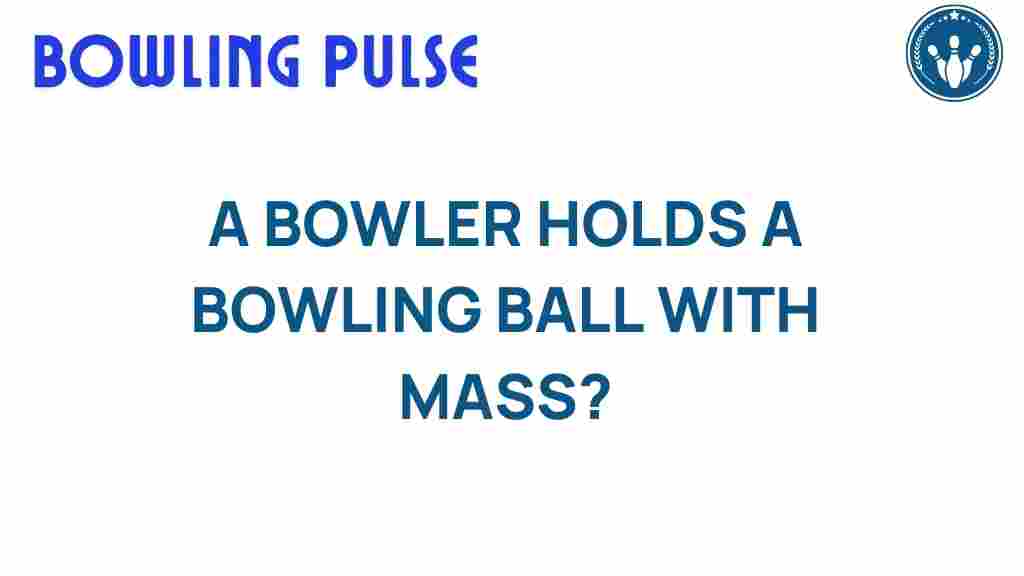The Physics Behind a Bowler’s Grip: How Mass Influences Performance
In the world of bowling, understanding the physics behind a bowler’s grip is essential for enhancing performance. The grip technique, combined with the mass of the bowling ball, plays a significant role in determining how effectively a bowler can deliver their shot. This article explores the intricate relationship between physics, biomechanics, and sports science, providing insight into how balance and strength can influence a bowler’s performance.
Understanding the Basics of Bowling Physics
Bowling is not merely a game of chance; it is a sport that involves precise movements and techniques. The physics of bowling can be broken down into several key components:
- Mass: The weight of the bowling ball affects how it is handled and thrown.
- Grip Technique: The way a bowler holds the ball is crucial for control and accuracy.
- Balance: Proper weight distribution is essential for a stable delivery.
- Strength: Physical conditioning can influence how well a bowler can execute their technique.
By mastering these elements, bowlers can optimize their performance on the lanes.
The Role of Mass in Bowling
The mass of a bowling ball significantly affects its performance. According to the laws of physics, mass influences inertia and momentum. Here’s how:
- Inertia: A heavier bowling ball requires more force to accelerate. This means that bowlers need to apply greater strength when using a heavier ball.
- Momentum: The momentum of a bowling ball at the moment of release determines how it travels down the lane. A heavier ball can create more momentum, potentially leading to a more powerful strike.
Choosing the right ball weight is essential. Most bowlers select a ball that is approximately 10% of their body weight, but personal preference and strength also play a role.
Grip Technique: The Key to Control
Grip technique is one of the most critical aspects of bowling. A proper grip ensures that the bowler can control the ball’s release and spin. Here are some common grip techniques:
- Conventional Grip: This grip involves inserting the thumb fully into the ball, with the middle and ring fingers inserted up to the second knuckle. This grip is excellent for beginners as it provides stability.
- Fingertip Grip: In this grip, the thumb is fully inserted while the fingers are only inserted up to the first knuckle. This grip allows for more spin and is favored by more advanced bowlers.
- Semi-Fingertip Grip: A hybrid grip that combines elements of both conventional and fingertip grips. It offers a balance between control and spin.
Each grip technique affects how the bowler interacts with the ball, influencing the overall performance.
Biomechanics of a Bowler’s Motion
The biomechanics of bowling encompass the study of movement and body mechanics. A bowler’s motion can be broken down into several phases:
- Approach: This is where the bowler builds momentum. A balanced stance and proper footwork are critical here.
- Release: The moment the bowler lets go of the ball. This phase requires precise timing and grip technique to ensure the ball is delivered accurately.
- Follow-through: After the release, the bowler’s arm continues in motion, which helps maintain balance and power.
Understanding these phases helps bowlers refine their technique and improve their overall performance.
Balance: The Foundation of a Good Delivery
Balance is fundamental in bowling. A well-balanced bowler is less likely to fall off their shot, leading to more consistent deliveries. Key principles of balance include:
- Center of Gravity: A bowler’s center of gravity should ideally be aligned over their feet during the delivery.
- Stance: A stable, athletic stance provides a solid base for the bowler to execute their approach.
- Footwork: Proper footwork helps maintain balance throughout the approach and release phases.
Practicing balance drills and incorporating strength training can help bowlers achieve better stability during their throws.
Strength Training for Bowlers
Physical strength plays a significant role in a bowler’s performance. Strength training can help bowlers increase their power and control. Effective exercises include:
- Core Strength: Exercises such as planks and Russian twists enhance core stability, which is crucial for maintaining balance.
- Upper Body Strength: Push-ups, pull-ups, and weightlifting can improve the arm and shoulder strength necessary for a powerful throw.
- Leg Strength: Squats and lunges build the leg muscles that propel the bowler forward during their approach.
By incorporating these exercises into their training regime, bowlers can significantly enhance their performance.
Troubleshooting Common Grip Issues
Even experienced bowlers can face issues with their grip. Here are some common problems and solutions:
- Too Tight Grip: If the grip is too tight, it can lead to loss of control or poor release. Solution: Relax the grip and focus on a smooth release.
- Too Loose Grip: A loose grip may result in the ball slipping from the hands. Solution: Adjust the grip technique and ensure the fingers are properly inserted into the ball.
- Finger Pain: Discomfort in the fingers can indicate improper grip technique. Solution: Consider adjusting the finger holes or grip technique to alleviate pressure.
By addressing these common grip issues, bowlers can improve their overall performance.
Conclusion: Mastering the Physics of Bowling
Understanding the physics behind a bowler’s grip is vital for improving performance in bowling. By focusing on mass, grip technique, balance, and strength, bowlers can refine their skills and elevate their game. The integration of sports science and biomechanics not only enhances performance but also reduces the risk of injury.
For bowlers looking to delve deeper into the science of their sport, numerous resources are available. Consider visiting this link for more information on sports science applications in bowling.
In summary, the right combination of technique and physical conditioning can lead to remarkable improvements in performance. Whether you are a beginner or an experienced bowler, understanding and applying the principles of physics can help you achieve your goals on the lanes.
This article is in the category Techniques and created by BowlingPulse Team
